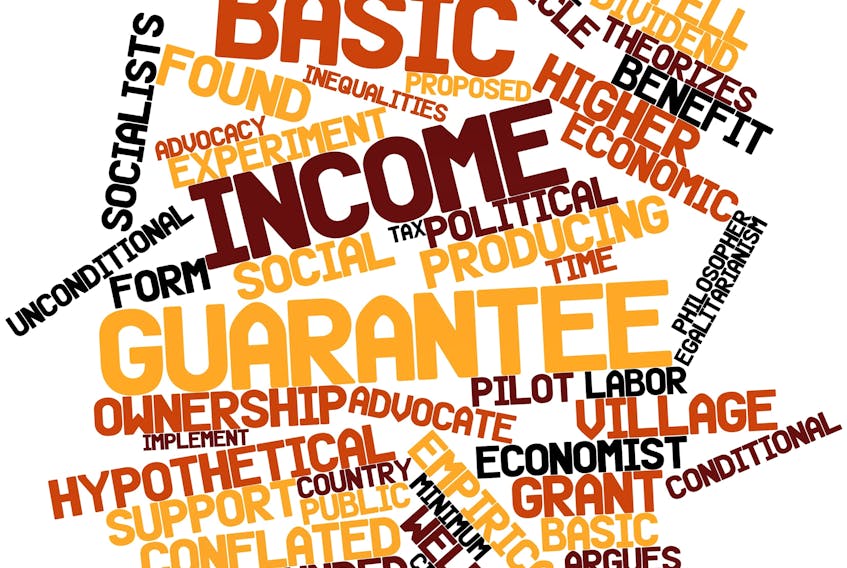This is the second of a two-part look at the proposed basic income guarantee (BIG) for P.E.I. In Part 1 I set out the context on poverty and income support.
P.E.I. is seeking federal funding to launch a pilot BIG project. BIG would provide monthly assistance through the income tax system to households below the poverty line.
If the project design is to be similar to a recent Ontario pilot project, BIG would ensure incomes of roughly $17,000 for singles and $24,000 for couples. I would expect perhaps 6,000 to 8,0000 P.E.I. households would qualify for assistance.
A legislative committee is now calculating possible expenditures, but based on national analysis and scaled down to P.E.I. numbers, I would expect the net cost of BIG on P.E.I. to be perhaps $85 million per year.
How does the ordinary person interpret a number like $85 million? Since the public would be putting up the money one way or another, let's express it per taxpayer. If the cost of BIG had to be borne by P.E.I. taxpayers it would amount to hundreds of dollars per household.
We, of course, are asking the feds to absorb this cost for the pilot but if the plan was to go national we would have to bear our share.
The substantial cost of BIG, especially in these COVID-19 times, is not an automatic reason to reject it. After all, some things are worth the price. The price tag does, however, raise a red flag.
Advocates of BIG respond that with improvements to the health, security and well-being of recipients the demand for services such as health, justice and housing will drop. This could mean long-term savings, thus offsetting initial BIG costs.
This reasoning may be overly optimistic. If, for example, the demand for health services were to drop, it would be more likely that current spending would be reallocated rather than cut. BIG might slow the rate of growth of spending or allow us to do more with existing budgets, but it would be unlikely to lead to the cuts necessary to offset new costs.
A second major concern about BIG is work disincentive.
Advocates rightly point to examples such as the Mincome project in Manitoba in the 19970s which found almost no disincentive to work. A guaranteed income does not "make people lazy" at least in the short term. Long-term behaviour may be a different matter.
Businesses and governments know a truth about human behaviour: people respond to incentives, or in this case disincentives. People are smart about government programs and where their best interests lie. This is illustrated by the employment insurance system. With the BIG clawback mechanism there is relatively little to be gained by accepting part-time or low-wage work.
There is also a structural problem with any guaranteed income program. The assistance is based on income tax returns so that the income figures are an average of 18 months old. For example, if we had a guaranteed income right now the assistance would be based on 2018 income.
So, as established in Part 1, I see a need for greater income support and the advisability of moving from welfare assistance to an income guarantee. Yet, there are concerns about the BIG. I would therefore like to propose what I feel might be a more affordable and perhaps more effective variation.
I would like to see a more modest guaranteed annual income with thresholds set part way between current welfare levels and the official poverty line. I would then like to exempt the first several thousand dollars of earned income from any clawback so that there is a more appealing work incentive. Lastly, I would like to see more generous financial support for persons with disabilities or who are unable to work.
How, you may ask, could I justify stranding recipients below Canada's official poverty line? There is nothing magic about the Market Basket Measure. People can, and do, live productive lives on incomes below the MBM. The greatest need is to raise those now at absolute poverty levels.
With COVID-19 expenditures and pressing needs in long-term care and childcare, perhaps it is time to model a more modest guaranteed income proposal.
Of course, income support will remain only part of a broader poverty reduction strategy. Needs for a vibrant economy, skills development, literacy, disability services, etc. will remain strong. I like to think that our overall objective is to empower people to help them reach their full potential. I am hopeful that we can have a more affordable guaranteed income that can help achieve exactly that.
Don Pridmore, of Charlottetown, is a retired civil servant who worked for the Department of Health and Social Services in the 1990s. Read Part 1 of his guest opinion online and in the June 10 print edition of The Guardian.









